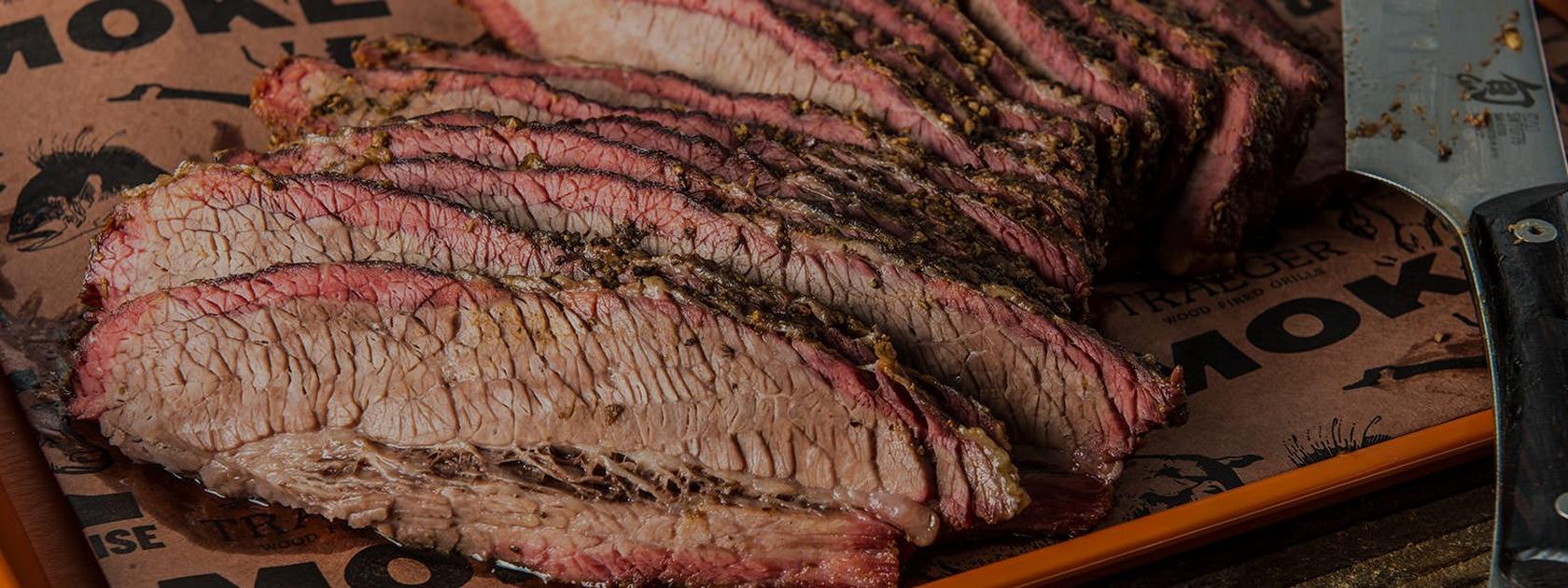
Smoked brisket is the holy grail of BBQ, and learning how to smoke a brisket like a pro is a huge notch in your pitmaster belt. While there are many ways to flavor a brisket, cooking it properly doesn’t leave quite as much room for experimentation or error. Brisket is a muscular, tough cut of meat, so low and slow is the way to go when learning how to cook a brisket. When prepared correctly on a pellet grill, a smoked brisket is tender, juicy, and irresistible.
Step-By-Step On How to Smoke a Brisket
Smoking a brisket is an art that requires patience and precision (and is entirely worth the work). From selecting the perfect cut to infusing it with rich smokiness, every step is an opportunity to craft something truly special. Join us as we delve into the art of brisket smoking, uncovering tips, techniques, and the essence of what makes this process both an art and a science. Follow these steps:
1. Select Your Brisket: When choosing a brisket, prioritize marbling for tenderness and flavor. Opt for a firm texture and a thick, even fat cap to ensure juiciness. Look for grades like Choice or Prime for top-quality meat, as these are widely recognized for their superior quality in grocery stores and butcher shops.
2.) Trim the Brisket: Nearly all BBQ experts will trim their brisket before smoking. When you trim the brisket, you'll want to keep these steps in mind (keep scrolling for the nitty gritty on trimming):
- Get rid of "hard fat" that isn't going to render during the smoking process when learning how to smoke a brisket
- Remove fat that will prevent you from directly seasoning the meat
- Eliminate any unattractive edge meat that could make the finished product look less attractive.
3.) Season Your Brisket: Brisket lovers everywhere have their own taste preferences and styles for seasoning brisket; in fact, many championship BBQers use nothing more than salt and pepper.
Just make sure to season at least 24 hours beforehand and let it chill in the fridge.
For a deeper dive into pro seasoning styles, see the Tools & Ingredients section below.
4.) Spritzing Your Brisket (Optional): If you decide to go the brisket spritz route, make sure you do it around the 2-3 hour mark before you wrap. That's when the bark starts forming. You'll continue to spritz every 45-60 minutes until you wrap.
5.) Wrap The Brisket: For melt-in-your-mouth texture and delicious carmelized bark, wrapping your brisket is essential, whether you use foil or butcher paper. Watch the video below for a step-by-step process and keep scrolling to learn the differences between wrapping with foil and wrapping with butcher paper.
5.) Smoke Your Brisket: Pick your wood pellets and get to smoking! Whether you want your brisket fat side up or fat side down, you'll have your brisket smoke for several hours at around 180-225°F until the internal temperature reaches around 200-205°F (make sure to use a wireless leave-in meat thermometer for best results).

6.) Rest Your Brisket: Resting is where the magic happens. Juices redistribute and the texture improves. Rest it for at least 30 minutes — or even better, up to 3+ hours in a cooler wrapped in towels.
7.) Slice Your Brisket: If you need to know anything about cutting your brisket for serving, it's that you need to slice AGAINST the grain for maximum tenderness. Look below for step-by-step instructions.
8.) Serve!
Tools & Ingredients For Smoking Brisket
Smoking brisket like a pitmaster starts with the right tools and ingredients. Whether you're sticking to a Texas-style approach or exploring competition-level prep, here’s what you’ll need to get the job done right.
Tools
-
A pellet smoker (We recommend the Woodridge Series or Timberline XL for consistent temperature and wood-fired flavor)
-
Large cutting board
-
A leave-in meat thermometer (learn how to use it like a pro here)
-
Butcher paper
-
Chef’s knife
-
Spritzing bottle (optional)
Ingredients
Seasoning brisket is all about balance and simplicity. While flavor preferences vary, here are the most common methods professionals swear by:
Texas Pitmasters (Gold Standard)
-
A 50/50 blend of kosher salt and coarse black pepper
-
Some add garlic powder or onion powder
-
This minimalist approach lets the beef and smoke shine
Competition BBQ Approach
-
Start with salt and pepper, then layer in a sweeter rub like brown sugar and paprika
-
Injections (like beef broth or a phosphate blend) are often used to keep the brisket juicy
-
Pitmasters build flavor in layers and may finish with a dusting rub after the cook
Common Ingredients Used by the Pros
-
Kosher salt
-
Coarse black pepper (16-mesh preferred)
-
Garlic powder
-
Onion powder
-
Paprika (for color)
-
Brown sugar (sparingly used for caramelization)
Use Our Rubs & Marinades
Our brisket-friendly rubs are dialed in for flavor and bark:
Pro Tip: Apply your seasoning liberally and let the brisket rest in the fridge overnight for max bark and flavor development.
Best Wood Pellets for Smoked Brisket
When it comes to the best pellets for brisket and epic smoke flavors, hickory pellets are often mentioned for their bold, robust flavor. Some like to mix it with a milder wood like maple to balance the intensity (Traeger Signature Blend Pellets combine these flavors), while others sweeten the profile with apple wood pellets, or cherry wood pellets. Any or all of these smoke flavors are a safe bet for smoked brisket.
Want to switch it up? Try pecan pellets for a nutty flavor, or a whiskey and oak blend for a sweet and smoky taste.
How to Trim a Brisket
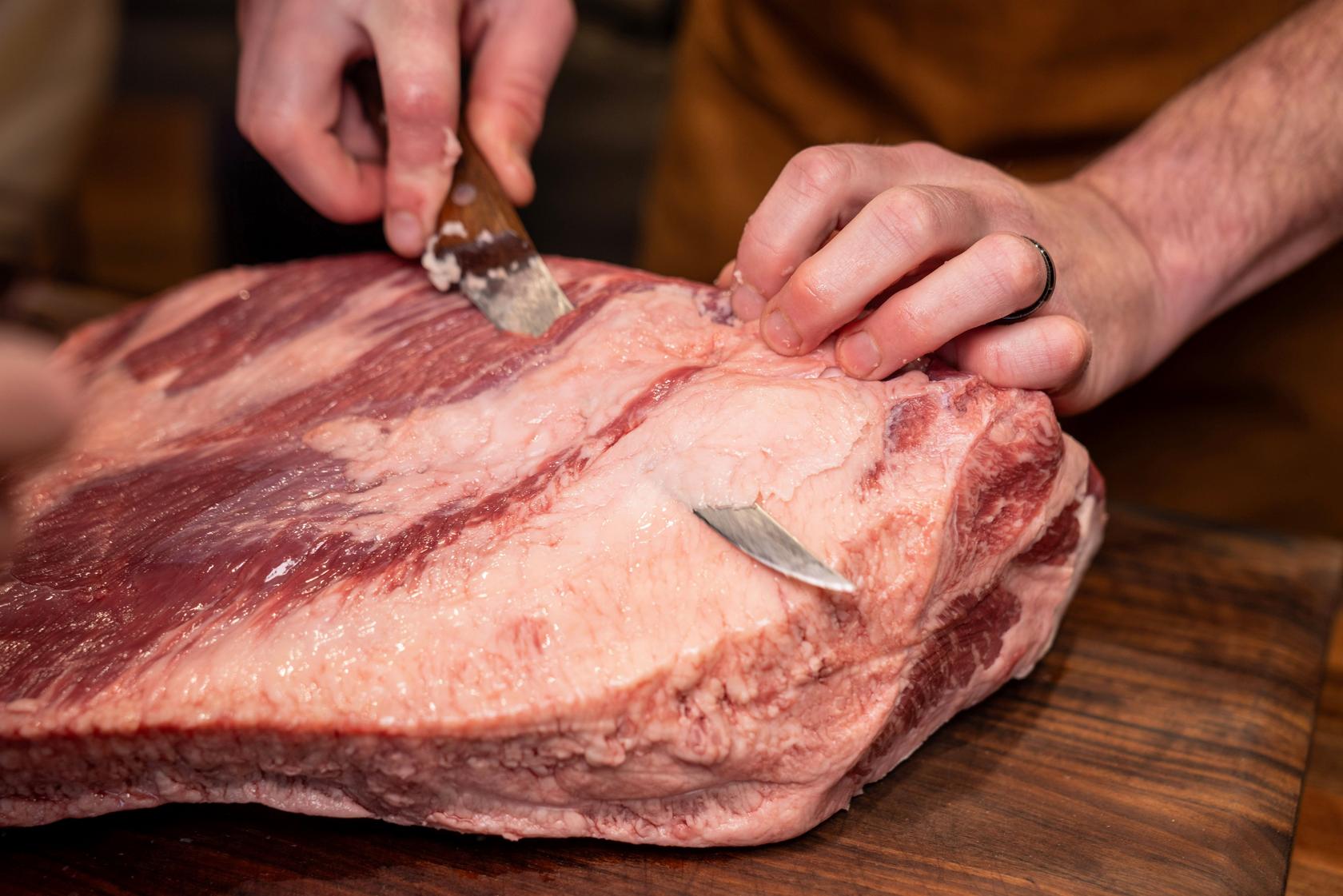
Much of trimming comes down to personal preference, but most pitmasters trim about two pounds off before the brisket hits the grill. Here's a step-by-step look:
-
Start with the fat cap facing up and pat the brisket dry with a paper towel.
-
Trim the fat cap down until you have an even 1/4-inch layer.
-
Flip the brisket over and trim off all fat and silver skin from the top (a thin membrane of connective tissue).
-
Remove the large chunk of hard fat found where the flat and point connect.
Learning how to cut brisket not only improves appearances, but it also helps seasoning stick and ensures the bark forms evenly.
What Temp to Smoke Brisket
Brisket should be smoked low and slow at a temperature between 180–225°F. This allows the fat and connective tissue to slowly break down, creating that tender, juicy bite everyone’s chasing.
Most pitmasters aim to pull the brisket off the grill at an internal temp of 200–205°F.
Because of Traeger's Set-It & Forget-It feature, you are able to set your desired temperature, throw in your brisket, and let the grill do the work so you don't have to monitor your brisket temperature the whole time.
How Long To Smoke a Brisket
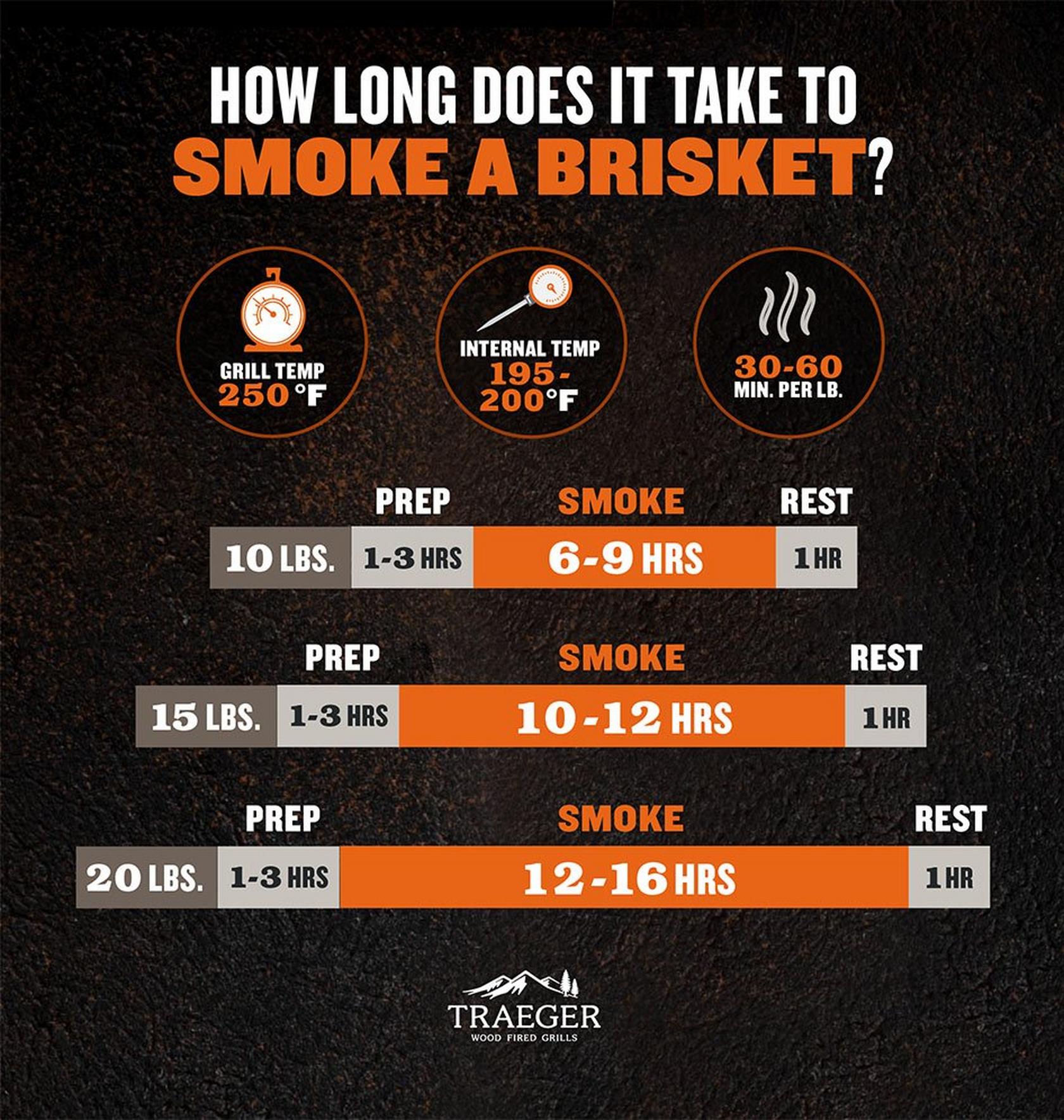
Every brisket is different, but here's a general rule of thumb for cook time:
-
10 lbs: Smoke for 6–9 hours, then rest for at least 1 hour
-
15 lbs: Smoke for 10–12 hours, then rest for at least 1 hour
-
20 lbs: Smoke for 12–16 hours, then rest for at least 1 hour
Plan for 30–60 minutes per pound at 225°F
The total process (trimming, injection, seasoning, cooking) can take 18–20 hours, so give yourself enough time.
Internal temp rules the cook, not the clock.
How to Wrap a Brisket
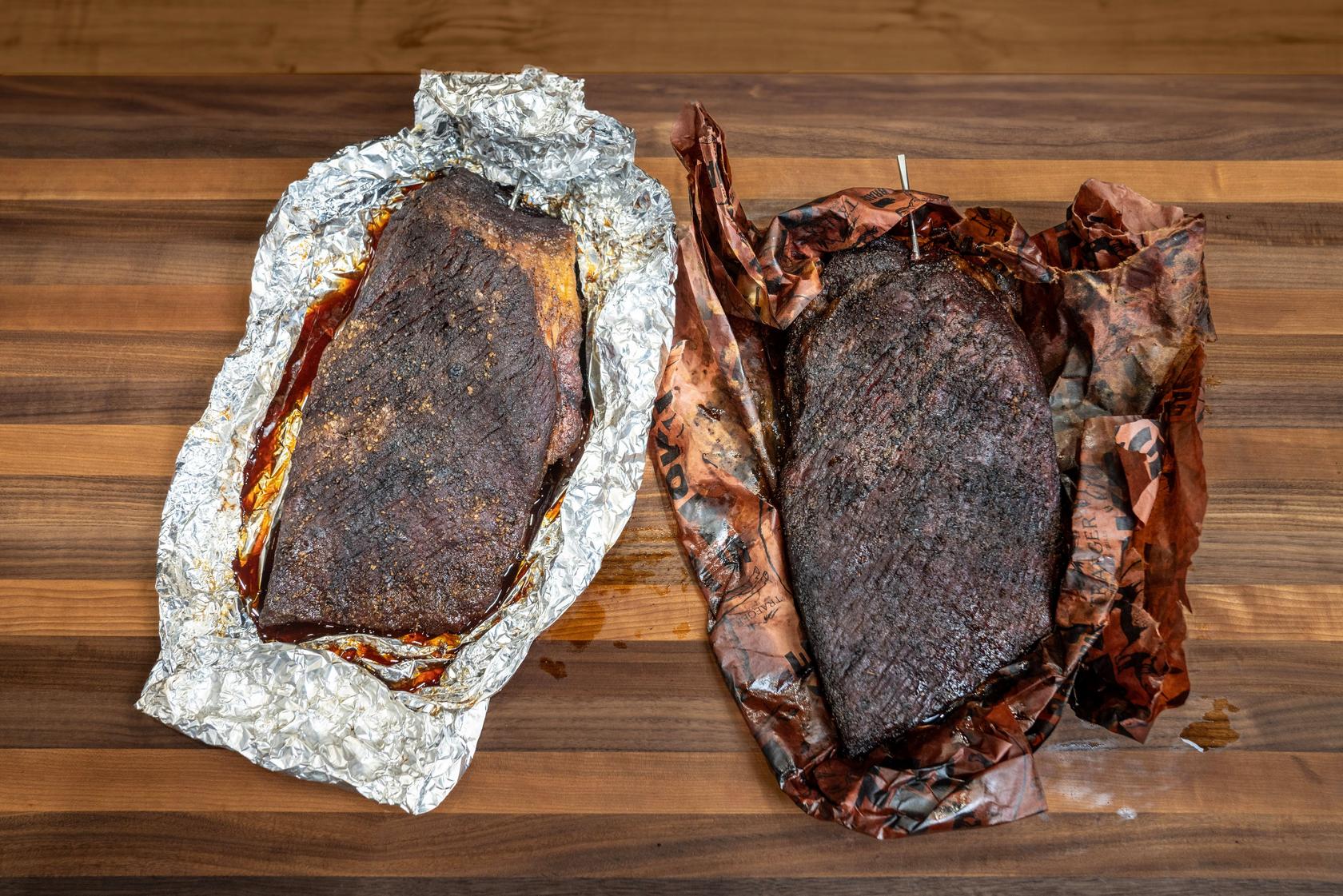
One commonly used method when learning how to smoke a brisket is wrapping brisket in foil or butcher paper.
Wrapping the brisket will prevent (or at least lessen) what's called "the stall" — when evaporation from the surface of the brisket halts the cooking process. It also gives you more control over the final appearance of the bark, and can help lock in moisture that would otherwise be lost as the brisket cooks.
But do you wrap your brisket in foil or paper?
Long answer short, there's no definite answer. Some smokers opt to wrap their brisket in foil to create a tighter seal, which helps retain moisture and results in a more tender finished product. On the other hand, wrapping in butcher paper allows for breathability, promoting the formation of a flavorful bark while still providing some insulation. It's a choice between moisture retention and bark development, each method offering its own unique advantages to achieve the desired brisket texture and flavor profile.
Pro Tip: Most pitmasters recommend wrapping the brisket when the internal temperature of the meat reaches 165-170 degrees.
How Long to Rest Brisket
Resting brisket is just as important as cooking it. During rest, juices redistribute throughout the meat, improving flavor and texture.
-
Minimum rest time: 30 minutes
-
Ideal rest time: 2–3 hours
-
Extended rest: Up to 4+ hours in an insulated cooler
Wrap your brisket in a towel and place it in a cooler to maintain temperature.
This also gives you flexibility on when to slice and serve.
How to Cut Brisket
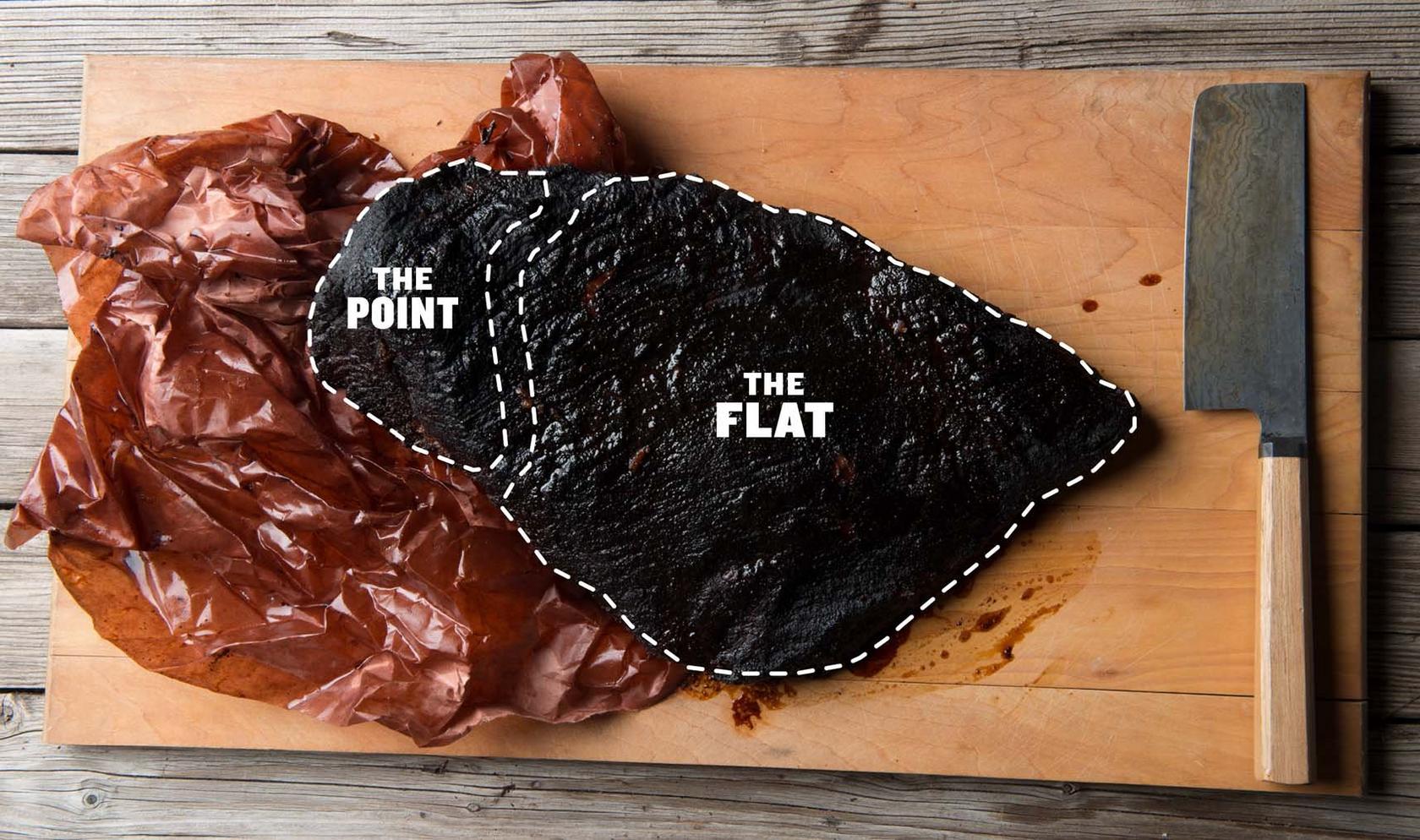
A full packer brisket is made up of two muscles: the flat and the point, each with different grain directions. For the most tender slices, always cut against the grain.
Step-by-step:
-
Slice the flat first (leaner part) across the grain.
-
When you reach the point (fattier section), rotate the brisket 90° and continue slicing.
-
Use a long, sharp slicing knife and aim for pencil-thin slices.
Cutting it right can make or break your final bite.
Should You Cook Brisket Fat Side Up or Fat Side Down?
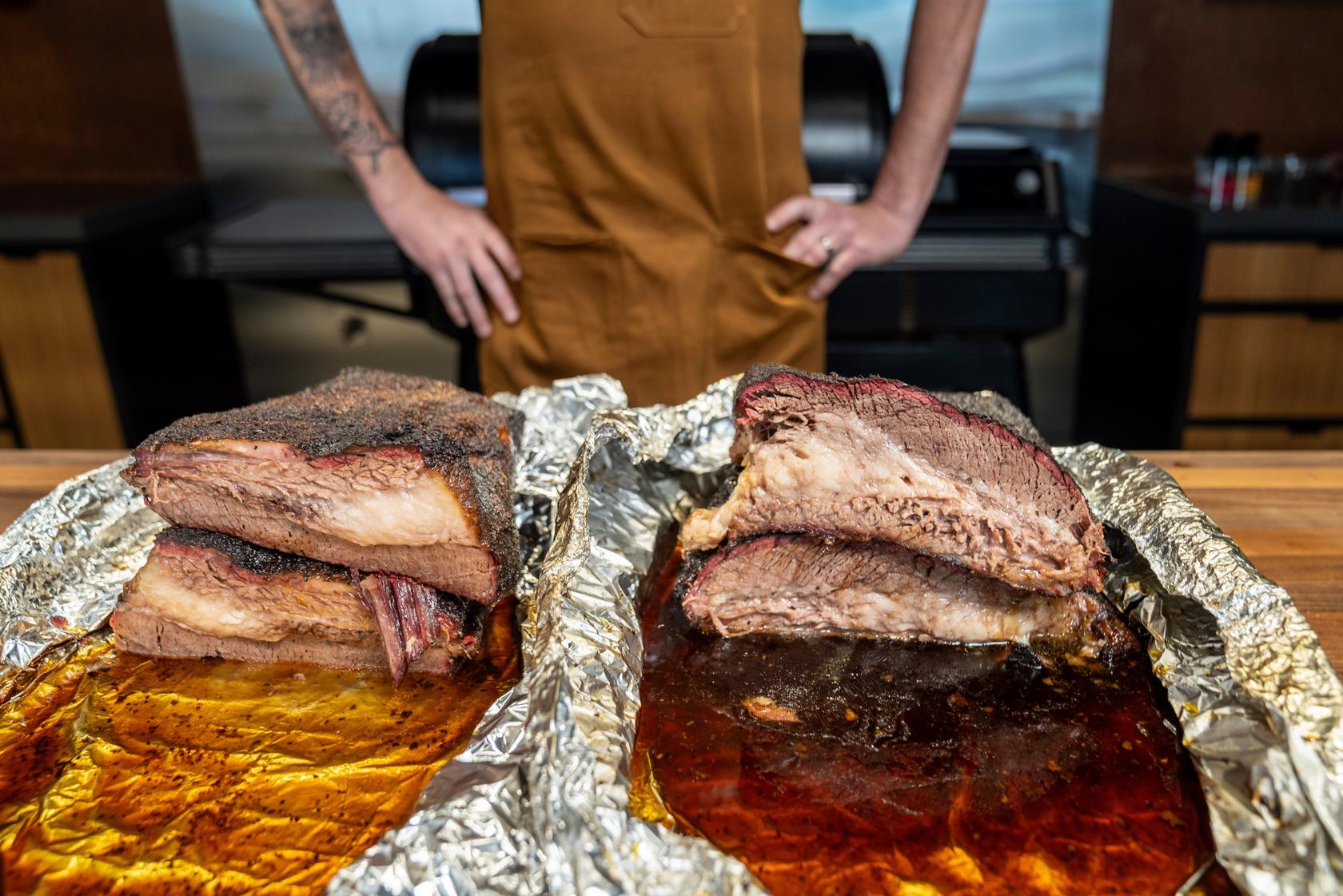
There's no wrong answer to this question; however, depending on your experience and taste, many BBQ lovers have a preference between fat side up vs. fat side down.
1. Fat Side Down: Advocates for placing the fat side down argue that it acts as a protective barrier against direct heat from the smoker, preventing the meat from drying out. The fat layer also helps insulate the meat, keeping it moist throughout the cooking process. Competition pitmasters also like that it can give the brisket a better smoke ring, and that cooking with the meat side up shows the grain better for more precise slicing.
2. Fat Side Up: Those who prefer to cook with the fat side up believe that as the brisket cooks, the fat renders downward, basting the meat naturally to keep it juicy. Because it's farther from the Traeger's heat source, less fat may be rendered, resulting in a pleasantly unctuous bite.
Tips For The Best Smoked Beef Brisket

- It’s recommended to get a full packer to cook. A full packer will include both the point and the flat. Ask your butcher if you aren't sure.
- Use fold/bend test when buying. Try folding the two ends of the brisket together. The more fold you get, the more tender the meat is likely to be.
- Use a 14-inch knife to trim.
- The colder the brisket is the easier it will be to trim.
- Tip: Save pieces for making carne asada.
- Bevel the edges of the brisket so there isn’t any fraying and edges don’t dry.
- Add finely ground coffee to your rub (or use our Traeger Coffee Rub) for a rich, complex flavor profile that enhances the smokiness of the brisket.
- Place a drip pan filled with onions, garlic, and beer underneath your brisket while smoking to capture flavorful drippings for basting or sauce.
- Allow your brisket to rest for at least an hour after cooking to let the juices redistribute, but resist the temptation to slice into it too soon to preserve its moisture and tenderness.
FAQ's
What cut of meat is brisket?
Brisket is a cut of beef from the lower chest or breast of the cow, specifically from the pectoral muscles. It’s a tough, heavily used muscle that becomes tender and flavorful when cooked low and slow, making it ideal for smoking. Brisket is typically sold as a whole “packer” cut, which includes two parts: the leaner flat and the fattier point.
What is teh best way to cook a brisket
Smoking is the best way to cook brisket because it breaks down the tough connective tissue over time while infusing the meat with deep, smoky flavor. The low-and-slow method allows the fat to render and the collagen to turn into gelatin, giving you tender, juicy slices with a flavorful bark on the outside. It’s the perfect match for a cut that needs time and heat to shine.
What's the 4-2-10 brisket rule?
The 4-2-10 method is a time-based smoking approach that's used to simplify the cook.
-
4 hours unwrapped: Smoke the brisket directly on the grill to build bark and absorb smoke flavor.
-
2 hours wrapped: Wrap the brisket in butcher paper or foil to speed up cooking and retain moisture.
-
10 hours resting: Let the brisket rest (typically in a cooler or warming oven) to allow juices to redistribute and the meat to fully tenderize.
Total: 16 hours, though internal temp is still the gold standard (aim for around 203°F before resting). This method is loved for its consistent results and tender brisket with great bark.
What is the danger zone for brisket?
The danger zone for brisket is between 40°F and 140°F. When smoking brisket on the Traeger, the brisket should pass through the 140°F mark within 4 hours of hitting the grill.
Is brisket tender or tough?
Brisket starts out tough because it is a heavily worked muscle with lots of connective tissue, but when cooked low and slow, especially by smoking, it becomes incredibly tender. The long cook time breaks down the collagen into gelatin, giving brisket its signature melt-in-your-mouth texture.
How to reheat brisket
When cooking a good amount of brisket, there’s bound to be leftovers, and there are plenty of ways to get creative with them. But if you’re just trying to enjoy the same flavor you had off the grill, all you need to do is cook your smoked brisket in its juices using a drip pan covered with aluminum foil until it reaches serving temperature (about 140 degrees).
If you want to mix up the flavor a little, try smoking it with different wood pellets, or add a splash of BBQ sauce, beer, or broth to your pan before cooking.
Should brisket fall apart?
Brisket shouldn't fall apart, but it should be tender enough to slice easily with a sharp knife.
How many calories are in brisket?
A 3-ounce serving of cooked brisket typically contains about 230 to 300 calories, depending on the fat content and how it’s prepared. The calorie count can be higher if the brisket has a lot of fat or is served with sauces.
Smoked Brisket Recipe
by Traeger Kitchen
139 Reviews
Prep Time
15 Min
Cook Time
9 Hr
Serves
8
Pellets
Apple
Embark on a flavor-packed journey with our mouthwatering smoked brisket recipe. Rubbed and slow-smoked to perfection, this signature brisket is a symphony of tenderness and bold smokiness, creating a culinary masterpiece that elevates any BBQ experience. Forget seconds, you’ll be coming back for thirds on this mouthwatering whole packer.
Ingredients
Rub
| 2 Tablespoon | garlic powder |
| 2 Tablespoon | onion powder |
| 2 Tablespoon | paprika |
| 2 Teaspoon | chile powder |
| 1/3 Cup | Jacobsen Salt or kosher salt |
| 1/3 Cup | coarse ground black pepper, divided |
main
| 1 | (12-14 lb) whole packer brisket, trimmed |
| 1 1/2 Cup | beef broth |
1
When ready to cook, set Traeger temperature to 225℉ and preheat, lid closed for 15 minutes. For optimal flavor, use Super Smoke if available.
2
For the Rub: Mix together garlic powder, onion powder, paprika, chili pepper, kosher salt and pepper in a small bowl.
3
Season the brisket on all sides with the rub.
4
Place brisket, fat side down on grill grate. Cook brisket until it reaches an internal temperature of 160℉, about 5 to 6 hours. When brisket reaches internal temperature of 160℉, remove from grill.
5
Double wrap meat in aluminum foil and add the beef broth to the foil packet. Return smoked brisket to grill and cook until it reaches an internal temperature of 204℉, about 3 hours more.
6
Once finished, remove from grill, unwrap from foil and let rest for 15 minutes. Slice against the grain and serve.